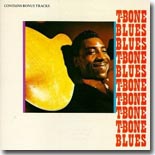|
T-Bone Walker
T-Bone Blues
Atlantic |

T-Bone Walker was one of the earliest, if not the first bluesmen,
to “plug in.” Walker, Charlie Christian and Eddie Durham were among the
first guitarists to use electric amplification on their acoustic
guitars, changing the face of modern music. In addition, his work led
countless other blues musicians of the ’40s, ’50s, and ’60s, such as B.
B. King, Roy Gaines, Pete Mayes, Pee Wee Crayton, and hundreds more, to
pick up a guitar, and has influenced many more over the past decades.
It’s safe to say that the blues would not be what is has become without
the presence of T-Bone Walker. His near-decade tenure in the 1940s with
Black & White Records (now owned by Capitol), coupled with his five-year
stint (1950-54) with Imperial, comprise as fine and consistent a body of
work as any musician, regardless of genre, has ever compiled.
Following his Imperial recordings, Walker recorded several sessions for
Atlantic Records, the first session in Chicago in 1955, and the two
subsequent sessions in Los Angeles in 1956 and 1957. The sessions were
compiled and released by Atlantic in 1960 as T-Bone Blues. In the
late ’80s, the session was reissued on CD with three bonus tracks.
The Chicago session features Walker with Junior Wells and Jimmy Rogers
on a couple of tracks, and a horn section that includes Goon Gardner
(alto sax), Eddie Chamblee (tenor sax), Mack Easton (baritone sax), John
Young (piano), Ramson Knowling (bass), and Leroy Jackson (drums). It’s
believed that Willie Dixon played bass and Francis Clay played drums on
the Walker/Wells/Rogers tracks. These selections (“T-Bone Blues Special”
and “Play On Little Girl”) represent Walker in a less urbane setting
than usual. The other three tracks include an outtake (“Why Not”) that
is thought to have led to one of Rogers’ biggest hits, “Walking By
Myself.”
The first L.A. session, recorded in mid-December 1956, features Walker
with Lloyd Glenn (piano), Billy Hadnot (bass), and Oscar Bradley (drums)
and include some classics, like “Mean Old World,” with its lengthy
guitar intro by Walker that was as good as anything he ever did. There’s
also a remake of Walker’s best-known tune, “Call It Stormy Monday.” This
song has been done to death over the past 50 years, but this version
shows you that despite all the other versions floating around, it is
clearly T-Bone Walker’s song (only Bobby Bland’s version for Duke
Records approaches it and it’s a distant second).
The title track is also a remake, the original being considered the
first blues recording to use electric guitar. The final two selections
from this section are instrumentals: “Blues for Marili” (a jazzy tribute
to Marili Morden, wife of Atlantic Records’ Nesuhi Etregun and a guiding
hand during Walker’s formidable years in L.A.) and the lively “Shufflin’
The Blues.”
The final L.A. session, recorded the next December in 1957, features
Walker and his longtime protégé R.S. Rankin (guitar), along with jazz
guitar great Barney Kessel, Plas Johnson (tenor sax), Ray Johnson
(piano), Joe Comfort (bass), and Earl Palmer (drums). The highlight is
the dynamic instrumental “Two Bones And A Pick,” a spectacular guitar
battle between the three guitarists. “Evenin’” features a moody vocal
from Walker, while Rankin (Whatever happened to him?) takes the
microphone for the bonus cut “You Don’t Know What You’re Doing.” The
closing instrumental, “Blues Rock,” ventures into ’50s R&B with Plas
Johnson’s sax leading things off.
T-Bone Blues was probably Walker’s last essential release. Though
most of his following work retained its classy dignity, the times had
changed and the popularity of his brand of blues had waned. He soldiered
on, however, continuing to tour and record until his death in 1975 from
the effects of a stroke suffered several months earlier.
Simply put, if you can only have one T-Bone Walker disc in your
collection, T-Bone Blues would be an excellent choice.
--- Graham Clarke